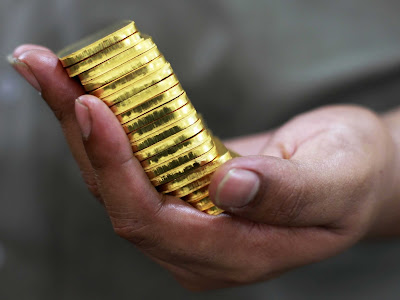By Mr. Prithviraj Kothari, MD, RSBL
AS 2015 came to a close, most traders expected that 2016 would be a year subjugated
by a series of Fed rate hikes.
That belief strengthened in late-December 2015 after the Fed delivered
on its promise – and raised interest rates for the first time in almost a
decade.
In a widely telegraphed publication called the "Dots Plot",
the Fed signalled that it would continue to normalize its monetary policy, and
raise interest rates by a total of +1% through 2016 to a target of 1.375%, a
"gradual" pace and in line with earlier forecasts.
Though gold was expected to be bearish on 2016, it showed upward prices
movements and The World Gold Council attributed this rally to three principal
factors:
- the widening landscape of negative interest rates in Japan and Europe;
- the devaluation of China's Yuan; and
- The realization that the Fed was bluffing on hiking the Fed funds rate, and wouldn't dare take any action that could knock the stock market lower ahead of the upcoming November elections in the US for Congress and the Presidency.
While we are a few months away from the year end I would like to throw
light on a few key highlights that influenced the bullion markets worldwide.
Fed Hike- on 4 January 2016, San Francisco
Fed chief John Williams said he saw a steady campaign of interest rate rises.
"There are still pretty significant headwinds" facing the US economy
from weak overseas economies, the strong Dollar and housing related issues, Mr.Williams
told reporters.
On 6 January, Fed deputy Stanley Fischer warned the markets could expect
three to four increases in the Fed funds rate this year. Speaking on CNBC
television Fischer warned:
"If
asset prices across the economy – that is, taking all financial markets into
account – are thought to be extremely high, raising the interest rate may be
the suitable step."
Based on expectations of 4-Fed rate hikes to 1.375% by year's end, gold
initially declined in the month of December to a six year low at $1054 per
ounce. Most analysts expected the downfall to continue through 2016, but they
were proved wrong.
The price of gold suddenly surged 16% higher in the first quarter
alone. Giving gold one of its strongest quarterly performance in nearly three
decades.
SPDR- The world's largest gold-backed
exchange-traded fund, SPDR Gold Shares (NYSEArca:GLD), surged in its holdings
to the most in six years, jumping to 983 tonnes, and global gold holdings in
ETFs topped 2,000 metric tonnes for the first time since June 2013 following
the Brexit fallout, when gold buying sparked even more gold buying.
BOS- by June 2016, all of Switzerland's government debt, including its
30-year bonds, started trading at negative yields.
In all, a record US$11.7 trillion of global sovereign debt has dipped to
sub-zero yield territory. This has only strengthened the rally in gold, and
about $13-14 billion of money has made its way into gold exchange-traded funds
(ETFs) as asset managers moved from fixed income into gold earlier this year.
Gold climbed to a two-year high at $1371 per ounce in July, convincing
UBS Group to predict that gold is probably at the beginning of its next bull
run
BOJ- gold's spectacular rally found a stiff roadblock at the $1370 per
ounce area when Japanese government bonds suddenly began to fall sharply into
their worst sell-off in 13 years. On August 2nd the Bank of Japan shocked the
markets and rattled gold traders by keeping its bond purchases steady, defying
expectations it would buy even more.
Gold traders became even more nervous after the BoJ said it would
re-evaluate its Negative Interest Rate and QQE policies in September. Some
investors see the policy review as a tacit admission by the central bank that
after more than three years of massive money printing, the BoJ could be ready
to start tapering the pace of the QQE liquidity injections.
Since the $10.4 trillion bond market in Tokyo is at the core of the negative
interest rate world, if the BoJ begins to allow Japanese bond yields to climb
by tapering its QE scheme, it could continue to rattle the price of gold – at
least on a short-term basis.
BoJ policy makers ordered staff to make a "comprehensive
assessment" on the impact of its easing program and negative interest-rate
policy ahead of the next policy-setting meeting on 20-21 September. Some
traders suspect the review is aimed specifically at assessing the effectiveness
of negative rates, potentially giving policy makers scope to declare the
exercise unsuccessful.
So for the month to come, BoJ will surely have something
crucial for gold in store.
The primary purpose of this article by Mr. Prithviraj Kothari is to
educate the masses of the current happenings in the Bullion world.
Previous blog:
"Higher Gold Prices For The Domestic Market: RSBL"
http://riddisiddhibullionsltd.blogspot.in/2016/08/higher-gold-prices-for-domestic-market.html








